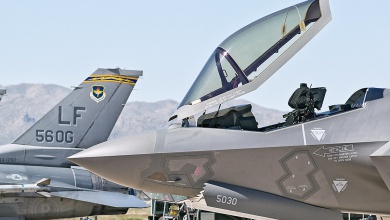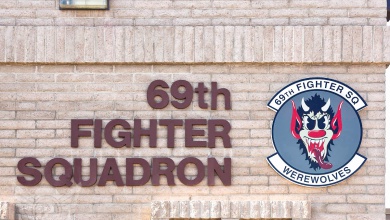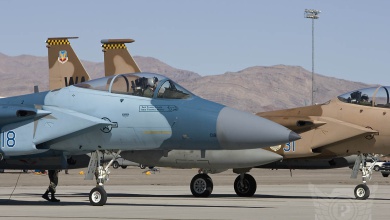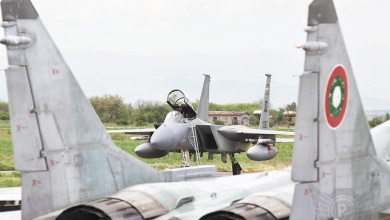Once a very familiar sight; Fairchild Republic A-10 Thunderbolt IIs landing at Spangdahlem Airbase in Germany, but ever since the 81st Fighter Squadron disbanded in 2013, only F-16s have remained. On February 13th, 2015, A-10Cs from the 354th Expeditionary Fighter Squadron ‘Bulldogs’, normally based at Davis Monthan Air Force Base in Tucson, Arizona, touched down at Spangdahlem for a six-month deployment in the European region. The Warthog is back to reclaim its territory!
Strategic capability
As a response to the Russian intervention in the Ukraine, the U.S. took immediate steps to express solidarity with its European allies. Designated as Operation Atlantic Resolve, the presence of air, ground and naval forces in Europe was instantly augmented to demonstrate a continues commitment to NATO in maintaining a collective security to ensure peace and stability in the region. Under the umbrella of United States European Command (EUCOM), the 3rd Air Force, responsible for both European and African operations, controls all air activities for Operation Atlantic Resolve together with subordinate United States Air Forces in Europe (USAFE).
A new method to expand air assets in the region is to deploy units under the concept of a so-called Theater Security Package (TSP) rotation. Lt. Gen. Darryl Roberson, 3rd Air Force / 17th Expeditionary Air Force commander clarified: “TSP is a long range, strategic capability to allow the Air Force greater flexibility against evolving threats. It is not tied to a specific platform or aircraft, but instead is a method of presenting forces at the right time to the right combatant commander. Our abilities must remain agile to sustain and increase regional security.”. He welcomed the 354th Expeditionary Fighter Squadron (EFS) at Spangdahlem Airbase (AB) on February 18th, 2015 being the first unit to fulfill a TSP deployment in Europe.
TSP is a long range, strategic capability to allow the Air Force greater flexibility against evolving threats. Lt. Gen. Roberson

Operational support
Lead for both current and all future TSPs is the 52nd Operations Group (OG) based at Spangdahlem AB. It also has operation control over the locally based subordinate 480th FS (operating F-16s), 606th Air Control Squadron (ACS) as well as running and managing the airfield. Col. Robert P. Winkler, 52nd OG commander, and his team are dedicated to support all forward deployed squadrons in every possible way. “We try to facilitate whatever they need, so whenever they are going forward they have the capacity and the capability to execute whatever mission as needed” he relates.
Although some A-10 heritage pictures have remained on the walls, the former 81st FS Operations building is now dedicated to TSP visitors. “We have changed it around” Col. Winkler says “It is now a contingency operation building irrelevant to what type of airframe that is in here; it can support anything.”. The infrastructure on the airfield has the capability to house two other fighter squadrons next to the 480th FS that is based here. Winkler continues: “We can handle any type of fighter, but it is nice having the A-10s!”.


Close to 350 personnel were brought in for this TSP; 300 Airmen from Davis Monthan Air Force Base (AFB) and another 50 in support from other locations. With some minor exceptions, all personnel will remain in Europe for the full duration of the TSP. To emphasize its forward deployed status, the unit is currently designated ‘Expeditionary Fighter Squadron’ according to Lt. Col. Steve ‘Cajun’ Behmer, 354th (E)FS commander. He also pointed out an interesting remark about their aircraft “Ten out of the twelve we brought with us were previously stationed here as part of the 81st FS. Once the 81st deactivated, they made their rounds and eventually turned up at our squadron. Coincidentally we now brought ten of them back here”. Most of the support equipment was also flown in, as all A-10 related material is no longer at Spangdahlem. Although certain maintenance equipment is interchangeable, they brought in everything necessary to remain autonomous when moving to other locations.

Away-games
The squadron was notified a month-and-a-half prior to the deployment, which was relatively short considering the large movement of people and aircraft. However, the 354th FS had a plan in place and was ready to go according to Commander Behmer: “As a former boss of mine used to say: ‘In the Air Force all of our games are away-games’ so we are always prepared to forward deploy”. Rather the biggest challenge turned out to be notifying all personnel, as it was the week before Christmas. “Everybody was out with their families on vacation. We did not want to interrupt some of that family time right before deployment” Behmer explains “But coming back for the new year, we had about a month time to get the squadron packed up and out the door.”.
With a total of 26, the squadron has brought a fairly large amount of pilots on this deployment. However, some of them just graduated A-10 training a couple of months ago and Behmer did not hesitate to bring them along. “The experience of flying in a different country in different weather conditions with different rules, for a pilot that is very interesting to build that airmanship” he commented. During the entire deployment, pilots will continue their routine training plan in accordance with the tasking outlined by EUCOM and USAFE. Their primary missions have not changed; Close Air Support (CAS), Combat Search And Rescue (CSAR) and Forward Air Control (FAC) is what the 354th EFS will maintain to support.


Seamless integration
The following Monday after their Friday arrival, the aircrew spend a day on just briefings about the local area as well as rules and regulations that come with flying in Europe. The first local flights took place the next day, led by two former 81st FS pilots that now fly with the 354th EFS. Their knowledge and familiarity with the airspace was very useful according to Lt. Col. Behmer: “We put them out to lead the initial sorties to train some guys. As they certified people to fly, more were able to train others, so it was kind of a waterfall effect that got everybody trained up”. Within a week everyone oriented themselves with the rules, surrounding airspace and some of the nearby ranges.
Operating out of Spangdahlem AB and integrating with the 52nd OG is described as ‘seamless’ by commander Behmer. Apart for the excellent facilities and support on base, this first ‘hub’ also allowed the 354th EFS easy access to a wide variety of ranges in Germany, Belgium, The Netherlands and France. A substantial part of their scheduled sorties is related to train with allies that essentially have Joint Terminal Attack Controllers (JTACs) capability. Besides flying local sorties, some type of missions may require crews to travel further. “We have the capability, just like we would anywhere else, to send a four-ship or a six-ship somewhere for a week, operate there and then go back to our hub.” Behmer says “As an example, we have four A-10s at RAF Lakenheath right now doing CSAR operations out there with a U.S. helicopter squadron that we are working with.”.

Next move
Plans on where the 354th EFS will go from here are continuously evolving. General Robertson specifically mentioned three primary location in his welcoming speech; Poland, Romania and the Baltic States. Lt. Col. Behmer is expecting to move to Romania soon: “We will do Sustained Ops there at our next location and eventually return back here to Spangdahlem.”. The majority of the people will also move to Romania, complemented by some additional infrastructure support personnel.
At some point the 354th EFS will also go to Poland on which Col. Winkler is able to reveal some background information: “The 52nd OG has an aviation detachment [Detachment 1] with a permanently party in Poland. We operate out of two bases; one is Łask and the other airbase is Powidz. Right now we have continuously C-130s that are currently at Powidz.”. So most likely the 354th EFS will also operate out of Powidz, as most detachment personnel is already there.


Training with allies all over Europe
We have the capability, just like we would anywhere else, to send a four-ship or a six-ship somewhere for a week, operate there and then go back to our hub.
Lt. Col. Behmer
Future packages
The next TSP is already lined up with the 125th Fighter Wing, Florida Air National Guard from Jacksonville, Florida scheduled to arrive in Europe in April. After an initial stop at Leeuwarden Airbase in The Netherlands to participate in the annually held Frisian Flag exercise, this unit will later also relocate to Spangdahlem. However, not every package will automatically go through here as Col. Winkler points out: “Because of our organizational structure it is not necessarily required to have a unit show up here. We know of additional forces that are coming and we are nailing down exactly where they are going to.”. His main focus for the rotational presence of TSP units already spans from today until September 2015 at this point. “I know that we are putting a group into Poland in June and they are going direct and not stopping in here. So it just depends on what is required and what is the most efficient way.” he adds.

TSP deployments were already introduced in the Pacific region back in 2004 and have evolved into what is considered a well proven concept. This new European TSP variation really fits the dynamic character of Operation Atlantic Resolve and has the potential to further enhance interoperability between NATO allies. In general, the TSP set-up, as presented to the higher command, is exactly the same for both regions. Based on personal experience, Col. Winkler can however name one major difference: “I have been in the Pacific as well and flying over here under the NATO umbrella in the European Theater is easier; we are all part of NATO, we fly under the same rules, we all operate the same STANAGs [Standardization Agreements]”.
As new packages are already lined up and preparing for deployment, the Bulldogs will continue their busy training schedule while ‘hubbing’ through various parts of Europe. Now with Operation Atlantic Resolve in continues full motion, Theater Security Packages and other Air Force rotations are likely to become routine rather than a rarity.




Acknowledgement
Phodocu would like to thank 52nd Operations Group commander Col. Winkler, 354th Expeditionary Fighter Squadron commander Lt. Col. Behmer as well as Chief Media Relations Iris Reiff and everyone else at the 52nd Fighter Wing Public Affairs for their effort and support.




